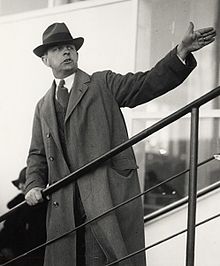Gregor Paulsson
Nils Bernhard Gregor Paulsson ( pronunciation : [ ˌgʁeːgɔʁ ˈpoːlsɔn ], born August 27, 1889 in Helsingborg , † 1977 ) was a Swedish art historian and mainly active at Uppsala University .
Gregor Paulsson was the son of a master tailor. He studied at Lund University , where he obtained his doctorate in 1915 with a thesis on Skåne's Renaissance art history . From 1916 to 1924 he was director of the National Museum in Stockholm and from 1920–34 he was chairman of the Swedish Association for Craft Art Svenska Slöjdföreningen . In 1919 he wrote the combat script Vackrare Vardagsvara ( prettier everyday object ) for Svenska Slödföreningen, which stipulated that well-formed and well thought-out objects should be accessible to everyone.
In 1930 Gregor Paulsson was chairman of Svenska Slöjdföreningen, together with the City of Stockholm, responsible for the Stockholm Exhibition in 1930 , which is widely regarded as the breakthrough for functionalism in Sweden. He was also co-author of the manifesto Acceptera , published the following year by the exhibition organizers .
From 1934 to 1956 Paulsson was Professor of Art History at Uppsala University. He published several art history handbooks such as Italiensk renässans (1937), Konstens världshistoria (1942) and Svensk stad (1950). He was married to Ester Wägner, the sister of the writer Elin Wägner .
Literature and Sources
- The social dimension of art . Translation by Rudolf Zeitler , Bern 1955
- Svensk form Internationell design , Bokförlaget DN, 2002
- Svensk Arkitektur , Byggförlaget, 1986
- Bonnier's Lexicon , Bonnier 1997
- Atli Magnus Seelow: Accept. The book and its story. German translation with introduction and commentary [with text by Gunnar Asplund, Wolter Gahn, Sven Markelius, Gregor Paulsson, Eskil Sundahl, Uno Åhrén]. FAU University Press, Erlangen 2018, ISBN 9783961471317 .
| personal data | |
|---|---|
| SURNAME | Paulsson, Gregor |
| ALTERNATIVE NAMES | Paulsson, Nils Bernhard Gregor (full name) |
| BRIEF DESCRIPTION | Swedish art historian |
| DATE OF BIRTH | August 27, 1889 |
| PLACE OF BIRTH | Helsingborg |
| DATE OF DEATH | 1977 |
